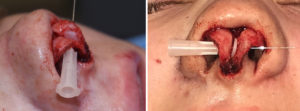Open rhinoplasty continues to be the most effective approach in a large number of nose reshaping patients. There is no question that the visualization provided to many of the critical structural elements that need to be modified creates the best opportunity to achieve the desired changes in a predictable manner. The tradeoffs to do so, the columellar scar and some prolonged tip edema, are usually worth the event aesthetic result.
One of the ‘invisible’ effects of an open rhinoplasty is the disruption of many of the soft tissue attachments between the tip of the nose and the upper lateral cartilages and septum. This is a seemingly innocuous effect done during the exposure but one that is well recognized to have adverse nasal tip changes after surgery. The loss of soft tissue support can cause the tip to droop or sag due to scar contracture as it heals, changing its shape and projection.
This has led to one of the basic maneuvers in open rhinoplasty, the placement of a columellar strut cartilage graft. By placing a vertical piece of cartilage between the medial footplates of the lower alar cartilages, a supportive ‘tent pole’ effect is obtained. This will provide support to the nasal tip and help it keep its position and shape created during surgery.

The non-rigid attachments of the nasal tip (which why the tip so freely moves and provides some protection from traumatic forces) make it susceptible to adverse effects of the surgery used to reshape it. The use of a columellar strut helps considerably in recreating structural support and is one reason why the tip of the nose will feel stiff for a long time after surgery.
Dr. Barry Eppley
Indianapolis, Indiana


